Françoise d’Aubigné, Marquise de Maintenon
A plague at the Hotel du Chaumont in Niort suggests Françoise d’Aubigné, the future Marquise de Maintenon, was born there… but that seems not to be quite true. Her father, Constant Agrippa d’Aubigné lodged in the city of Niort, in its prison to be precise, for allegedly conspiring against Cardinal Richelieu. He led quite the debauched life, murdered his wife along with her lover in 1619, and spent plenty of time in various prisons for various reasons. In prison, he met the sixteen year old Jeanne de Cardilhac and fell in love with her. Jeanne was not there due to a prison sentence, she was the daughter of Constant’s jailer.

They married in 1627 and their first child was born one year later, a boy named Constant. A second son, Charles, followed in 1634 and Françoise was born on November 27 in 1635, either inside the prison of Niort or just outside. Françoise was baptised in the Catholic faith of her mother on November 28, her father had Huguenot origins, but had abjured his faith in 1618. Françoise was born into a noble but poor family. Her grandfather being the famous poet and Huguenot General Agrippa d’Aubigné, who served Henri IV, the first Bourbon King of France. Thus her Godparents were also quite prominent. Suzanne de Baudéan, daughter of the Governor of Niort, and François V de La Rochefoucauld.
Françoise spent the first few months of her childhood in company of her Huguenot aunt Louise-Arthemise d’Aubigné, known as Madame de Villette, at the Chateau de Mursay. As her father was released from prison, after the death of Cardinal Richelieu, he managed to acquire Governorship of Marie-Galande, a tiny island close to Martinique, from the Compagnie des Îles de l’Amérique and the whole family moved to the exotic Martinique in the eastern Caribbean Sea.
Despite their Catholic baptism, the children received a Protestant education from their very strict mother, who only allowed them very few liberties. Nevertheless, Françoise would always happily think back about her time in Martinique, although the family struggled to survive with only little money at their disposal. Her father left them for France and died there in 1647.
Jeanne struggled to return with her children to France and made it to La Rochelle in a penniless condition. Françoise was given again into the care of their aunt Madame de Villette. The young girl was quite fond of her aunt and the aunt of her… but there was a bit of a problem. It was not considered good for Catholic girl to live in a household full of Protestant ideas and teachings. Her Godmother, Suzanne de Baudéan, now known as Madame de Neuillant served in the Household of Anne d’Autriche, later in that of Marie-Thérèse d’Autriche, and applied to her mistress for allowance to take the child from Madame de Villette in order to have it raised properly and in the proper faith.
Madame de Neuillant was a wealthy woman with a strong Catholic faith, but quite avaricious and not the kindest of persons. She sent Françoise, along with a mask to prevent her face from being burned by the sun and a book of devotions with passages marked to be learned by heart, to watch the turkeys on her property. Madame de Neuillant was not too worried about the physical well-being of her protege, yet incredibly worried about her soul. After all the child had been baptised Catholic and that aunt of hers dared to fill the girl’s head with Protestant ideas… now said girl was not inclined to stop with the Huguenot nonsense.
All of this meant convent for Françoise. She was placed against her will with the Ursulines of Niort and afterwards with the Ursulines of the rue Saint-Jacques in Paris. Françoise turned to her aunt in hopes something could be done about the situation, writing “Madame and aunt, the memory of all the kindnesses which you showered on our poor abandoned selves makes me stretch my hands towards you and beg you to use your influence and your efforts to save me from this place where life is worse than death. Oh ! madame and aunt, you do not know what a hell this so-called house of God is to me. . . .”
In vain. Madame de Villette could do nothing, since Madame de Neuillant had the Queen on her side. Françoise did not like the convent at all in first, but this changed as a Sœur Céleste took an interest in the girl. Françoise was allowed to attend or absent herself from religious services at pleasure, and a Huguenot minister was invited to the parlour to argue with a Catholic priest in her presence. In the end Catholic priest impressed her more than the Huguenot minister and Françoise d’Aubigné returned to the Roman Catholic faith.
Her return to what was considered the right faith, allowed Françoise to accompany Madame de Neuillant for gatherings with the finer Parisian society. During one of these gatherings, she received the nickname la belle Indienne from the Chevalier de Méré. A man who was not noble, nor had the right to call himself Chevalier, yet did it because he thought such a title would fit his gallant ways and ideas. During a other meeting, wearing a petticoat that was too short for her, she met the poet Paul Scarron. Monsieur Scarron contemplated a voyage to the Antilles for his health and sought advice from Françoise, who knew the islands. He was famous in Paris and entertained members of the noblesse in his salon. A witty man skilled with the quill, poet and novelist, supported by the very wealthy and very famous … and what was called a cripple. How he became one is not quite clear. One story says he fell into ice-cold water, a other that he hid in the waters of a swamp, it might have been also a case of polio that left him partially paralysed and in constant pain. His upper body became permanently twisted and his legs were paralysed. He was obliged to use a 17th century wheelchair and took copious amounts of opium to relieve his pain. Monsieur Scarron took a liking to Françoise and both started a correspondence with each other. Françoise was a intelligent girl with a quick mind, which did impress Monsieur Scarron. She had not a penny and no means whatsoever to support herself, which made him feel for her. Thus, as Françoise’s mother died and she was left with basically nothing, he kindly offered her to support her if she took in mind to join a convent…. or to marry her.

Madame de Neuillant, in her position as Françoise’s guardian, favoured marriage. Scarron is not handsome, nor is he rich, he lives en pension -from a pension granted to him- in the Hotel de Troyes. The great pro in the eyes of Madame de Neuillant was not just that she would finally be rid of Françoise and would no longer need to pay for her expenses, but also that Françoise would be able to establish a position for herself within the higher classes. As it was right now, she was nothing more than a poor orphaned girl with no future, no money, and the drops of noble blood in her veins did not count for much considering the rest. Françoise thought the same and a live in some musty convent was no option for her. The deal was sealed and the forty-two year old Paul Scarron married the sixteen year old Françoise d’Aubigné in April 1652.
In the next years the new Madame de Scarron climbed the social ladder step by step and became a woman celebrated for her intelligence and quick mind. The salon of the Scarron’s was a place of frequent comings and goings. The names of its visitors known in all of France. César Phébus d’Albret and the Abbé de Choisy, Ninon de l’Enclos and Madame de Sévigné. A certain Louis de Mornay, Marquis de Villarceaux, was among them as well and took a liking to Madame de Scarron. He had courted the famous Ninon de l’Enclos, who gave him a son, and now had an eye on Françoise. She was quite flattered by his attentions, it seems, and he took to visiting the salon of her husband regularly.
Françoise also made friends outside of the clique that visited her husband and visited several salons herself. In the Hôtel d’Albret, owned by her friend César Phébus d’Albret, she made acquaintances with Bonne de Pons, Madame de La Fayette and a certain Françoise de Montespan, who decided, inspired by the conversations in the Hôtel, that the name Athénaïs would suit her better.
Madame de Scarron was a dutiful wife and nursed her husband to the very end. He died in 1660 and wrote his own epitaph: He who sleeps here now, deserved more pity than envy, and suffered death a thousand times before losing his life. As you pass, do not make noise here, be careful not to wake him, because this is the first night that poor Scarron slumbers.
Now a widow, Madame Scarron found herself in financial troubles again. “Monsieur Scarron has left me 10,000 francs worth of assets and 22,000 francs of debts. . . . That is the state of the property of the poor fellow, who always had some chimera in his head and who spent everything he could realise in the hope of finding the philosopher’s stone or something equally probable.” she wrote to her uncle the Marquis de Villette (webkasino.at). Luckily for her, and thanks to her friend the Marechal de Villeroy, Anne d’Autriche took pity on her and continued to pay Monsieur Scarron’s pension to his widow, even increasing it to 2000 livres.
Françoise withdrew to more humble quarters in Paris, along with her servant Nanon, and lived a simple life. It is hard to say whether it is true or just rumours, but apparently the Marquis de Villarceaux became her lover during this time. A affair that is said to have lasted for three years and one she ended with the words “I do not want to see you here or anywhere else for a year, and then when we meet again we will meet like old friends, but the door to my room will be closed to you forever.” However a portrait painted by the Marquis de Villarceaux himself hints that the whole thing was true. Today it is in the château de Villarceaux and shows Madame Scarron as a Greek goddess in a state of undress.
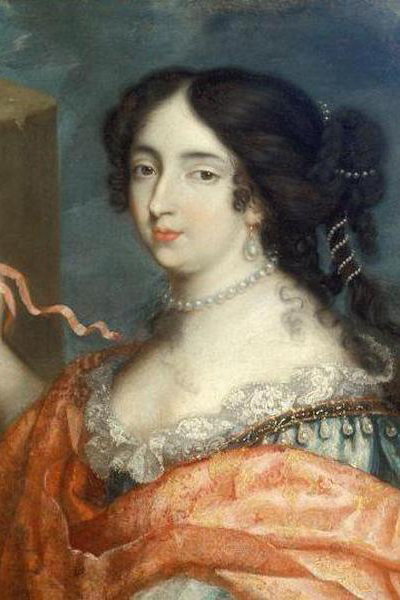
Later, as Marquise de Maintenon, Françoise seems to have done her very best to ignore those years of marriage and being a celebrated salon beauty with many admirers. She even wrote to her brother as one “who had never been married” and the Duc de Saint-Simon writes of an incident in which Racine mentioned Monsieur Scarron, saying he disgusted everybody, that did cost Racine his favour. (This early Françoise seems to be so very different from the black-dressed ghost that roamed Versailles and whispered into the Kings ear, it is hard to imagine it is the same person.) Whether she had affairs during or after her marriage, Françoise later acted as if it was not the case and she appeared very virtuos and not interested at all in such things. To her girls in Saint-Cyr she said “My character in this respect, was so well known that no man ever dared to offer me anything, except one who was a fool. I had a very pretty amber fan and I had put it for a moment on a table by my side. This man, either jokingly or on purpose, took up the fan and broke it in two. I was surprised and shocked, and extremely annoyed, for I was very fond of the fan. The next day this man sent me a dozen fans like the one he had broken. I sent him word that it wasn’t worth while breaking mine in order to send me a dozen others, and that I should have been just as well pleased with thirteen as with twelve. I sent him back his present and remained fanless, and made such fun of him in public that nobody ventured afterwards to take similar liberties.”
Financial troubles returned as Anne d’Autriche died and Louis XIV saw no reason to continue the pension, but luck was on the side of the widow Scarron once more. Marie-Françoise-Élisabeth de Savoie, the new Queen of Portugal, needed ladies for her household and Françoise was just about to leave Paris for Lisbon as a old friend knocked on her door. This friend was now the mistress of Louis XIV and pregnant. Françoise had to think about it, after all she was going for a pious lifestyle now, but a interview with King himself changed her mind and she agreed to become governess of the children of Madame de Montespan and the King. The utmost secrecy was demanded and Madame Scarron was the perfect choice to ensure the existence of the children remained as secret as possible. She moved into a house in the village of Vaugirard, outside of Paris. Françoise took care of the domestic duties herself, although she had staff at her disposal, and took care of her secret charges with the greatest care. “In the morning I went home (to her Paris home), let myself in by a back door and, after dressing, drove to the Hotel d’Albret, or de Richelieu, in order that my friends might not even suspect that I had a secret to keep.” she wrote later on.

The widow Scarron took a special liking to the second child that was placed into her care. The little Louis-Auguste, later known as Duc de Maine, had one leg shorter than the other and not the best health. Françoise acted as a doting governess, who was more mother to him that his actual mother, and took all measures to improve the boy’s health. She comforted him, visited a famous quack with him, took him to the waters of Bareges, all incognito of course. The King saw with what great affection Madame Scarron treated his children and took a liking to her in turn. Upon the death of the oldest of the children he said “She knows how to love, there would be pleasure in being loved by her.” The little Louis-Auguste was the King’s favourite child and the doting care Françoise showed him, impressed him even more.
Françoise time at court began in 1673 as her secret charges were legitimised by their father. There was no longer any need to hide and Madame Scarron moved to court with the children to continue looking after them. As their governess, Françoise was in a very special position at court from the start on. She had a privilege only few had, for she was able to speak to the King whenever necessary and speak with him almost in a familiar tone. Louis XIV appreciated her services greatly, although he was a little put off by the strict religious behaviour she adapted. Madame de Montespan, her old friend, treated her like a servant.
Athénaïs was not fond of the ways this no-one was treated by the King, and how he enjoyed her company, she even less liked the fact that Louis XIV gave Françoise quite the sum of money. Madame de Montespan tried to get rid of her in 1674 by marrying her to the Duc de Villars, but Françoise was not at all interested in it. All the tensions between her and Madame de Montespan made her more and more frustrated and even depressed. She wrote in 1674: “The coldness with which I am treated has increased since you left, and my friends, who have noticed it, have condoled with me on my disgrace. I spoke yesterday to Madame de Montespan about it, and told her that I hoped she and the king would not think that my low spirits were a sign of my being sulky with them. That the cause was more serious, that I saw clearly that I had lost her favour, and that she had prejudiced the king against me.” and in September the same year: “Madame de Montespan and I had a heated conversation this morning, and as I am the victim I have been crying a good deal, and she has given her own account of the matter to the king. . . . She describes me to him as she pleases, and loses me his esteem. Consequently he considers me an eccentric creature who has to be humoured. I dare not speak to the king directly because she would never forgive me and, if I did speak, my obligations to Madame de Montespan forbid me to say anything against her. So there is no remedy.” In February the next year, she wrote: “There have been terrible scenes between Madame de Montespan and myself, and yesterday the king was a witness of one of them. These quarrels are reducing me to such a state that I cannot endure it much longer.”
All of it made her so frustrated that she took in mind to give her position up: “I am firmly resolved to leave them at the end of the year.”
But fortune smiled at her again shortly later. Louis XIV gave her the sum of 200000 livres, a lot of money back then. With the money she purchased the property of Maintenon, along with a cozy chateau, which granted her an income of around 11000 livres a year. It did however not erase the wish to retire from her position and she thus began to plan her new life at Maintenon after visiting it. She still continued to pursue the idea as Louis XIV, apparently after Madame de Montespan quarrelled with her again, raised her Maintenon property to a Marquisate. Françoise d’Aubigné was no longer the widow Scarron, but the Marquise de Maintenon. A title equal to that of Madame de Montespan.

“I should like to rise at seven in the summer and eight in the winter, to spend an hour in prayer before summoning my maids, then to dress, and while so engaged to see the tradesmen and others with whom I shall have business to transact and, after dressing, to go to church, and not return till dinner. I should expect to go out about two days in the week, either for my pleasure or to pay necessary visits, to sup with private friends on those days, but always to come away at ten. Twice a week I should stay at home and entertain my private friends on those days, either at dinner or at supper, always withdrawing at ten to read prayers with my servants, and undressing and going to bed at eleven. The three other days of the week I should assign one to visiting the poor of my parish, one to visiting the hospital, and the third to visiting the prison and I should spend the evenings working or reading. I should never see anybody on the eve or day of Communions, never miss my private prayers, dress modestly, and never wear gold or silver and give the tenth part of my income to the poor. That is how I should like to begin, till religious zeal led me on to better things. I haven’t spoken about keeping Sundays and fete-days holy, for I consider that one of the most elementary duties.” ~ Madame de Maintenon to her confessor about how she wishes to live at Maintenon.
What kept her at court in the end was a disagreement between Louis XIV and Madame de Montespan, after which Françoise got the idea that not all may be lost yet when it comes to the spiritual welfare of the King and his soul. She made it her mission to bring him closer to God again. Her attempts were aided by the Church itself, which had taken up a stance against the King’s mistress and the behaviour of said mistress. Louis XIV got a little fed up with it as he took up a correspondence with the new Marquise de Maintenon, as the latter was travelling with the Duc de Maine for reasons of health. Françoise was in a much better mood, but had to discover to her great shock, as she returned to court with the little Duc, that her attempts were in vain and King and mistress reunited again.
The peace did not last long however and Madame de Montespan fell out of favour due to her involvement in the affaire des poisons. After the death of Mademoiselle de Fontanges, who was rumoured to have been poisoned, Madame de Maintenon’s time to rise came. The King was not a young man anymore and something about this Maintenon was appealing to him. She was not like the rest, not like those who sought his company to improve their fortunes, she actually cared for him…. Louis XIV was always fond of contrasts and new mistresses were never much like the previous ones. Montespan and Maintenon were like night and day. Perfect. Thus Louis approached the Marquise with the request to become his mistress and she said no… at least that is what she said later on.
Mistress or not, she was now in very good graces with Louis XIV. So good, that he spent several hours a day in her company. It was clear to see for everyone that time of Madame de Maintenon’s rule had begun. Unfortunately it meant that Versailles would never be like it was again. The ballroom days were over.
In 1680 Madame de Maintenon was offered the position of dame d’atour to the new Dauphine, Marie-Anne de Bavière. The Dauphine did not like her much. Madame de Richelieu, who had been a friend to Madame Scarron but not too much sympathy for Madame de Maintenon, had whispered all sorts of negative things to the Dauphine about the Marquise. Madame de Maintenon had not the best standing with her.
It did not matter much, for only a few years later Madame de Maintenon rose even higher by marrying the King in secret.
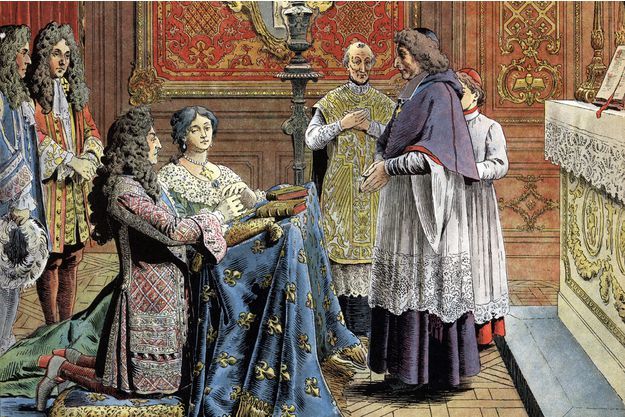
Marie-Thérèse d’Autriche, Queen of France and Navarre, passed away on July 30 in 1683, after a short and very painful illness. Since the King already had heirs enough, there was not much need to marry again for dynastic reasons. Political reasons were considered by a wedding to Anne-Marie-Louise de Toscane or the Infanta Isabelle du Portugal, but in the end dismissed.
No official documentation of the marriage exists and it is not quite clear whether it already happened in the night from the 9th to the 10th October 1683 or in January 1684, but Françoise d’Aubigné became the morganatic second wife of the great Sun King. It was a small private ceremony in the middle of the night with only few present. The King’s confessor Père la Chaise was there, as well as the Marquis de Montchevreuil, the Chevalier de Forbin, Louvois and Alexandre Bontemps. The whole thing was conducted by François de Harlay de Champvallon, Archbishop of Paris.
Saint-Simon, who was a boy as it happened, wrote: “But what is very certain and very true, is, that some time after the return of the King from Fontainebleau, and in the midst of the winter that followed the death of the Queen (posterity will with difficulty believe it, although perfectly true and proved), Père de la Chaise, confessor of the King, said mass at the dead of night in one of the King’s cabinets at Versailles. Bontems, governor of Versailles, chief valet on duty, and the most confidential of the four, was present at this mass, at which the monarch and La Maintenon were married in presence of Harlay, Archbishop of Paris, as diocesan, of Louvois (both of whom drew from the King a promise that he would never declare this marriage), and of Montchevreuil. … The satiety of the honeymoon, usually so fatal, and especially the honeymoon of such marriages, only consolidated the favour of Madame de Maintenon. Soon after, she astonished everybody by the apartments given to her at Versailles, at the top of the grand staircase facing those of the King and on the same floor. From that moment the King always passed some hours with her every day of his life; wherever she might be she was always lodged near him, and on the same floor if possible.”
Madame de Maintenon stayed nevertheless very humble. She refused the position of dame d’honneur to the Dauphine as it was offered, saying it was too grand a position for someone like her. Her old maid Nanon was still with her and her rooms at Versailles not as comfy as the courtiers thought they were. She still dressed humbly and in dark colours and spent most of her time inside her apartment, yet her influence could be felt everywhere although she was hardly ever seen in public by anyone.

Nevertheless, the reputation of the Marquise de Maintenon as scarecrow of Versailles was something she created partly herself due to her behaviour. Madame de Maintenon, with her constant talk of religion and gloomy air, was quite unpopular with a whole lot of people. The court was growing older, so did the King, and with her influence he turned towards religion and thought of afterlife. Over were the ballroom days. The days in which he shone brightly. And as Versailles turned more gloomy, the younger generations turned away from this splendid palace. Paris was the place to be again. The place where one could be merry without feeling the presence of that old judging woman everywhere.
Her attempts to do good where not too well received either. Liselotte von der Pfalz said about Madame de Maintenon “Where the devil can’t go, he sends an old woman” and this was pretty much what a lot of people thought of the Marquise, although they did not say it… for fears she might hear it. Although her political influence was not as great as many people of her time presumed, and her role in the revocation of the Edict of Nantes a little unclear, her influence on the King is hard to deny. Under the rule of Madame de Maintenant, as she was nicknamed, comedies and ballets were forbidden during Lent and her word decided matters of court politics, matters of religion, matters of entertainment, it decided who got what position and who was not invited to participate in court activities.
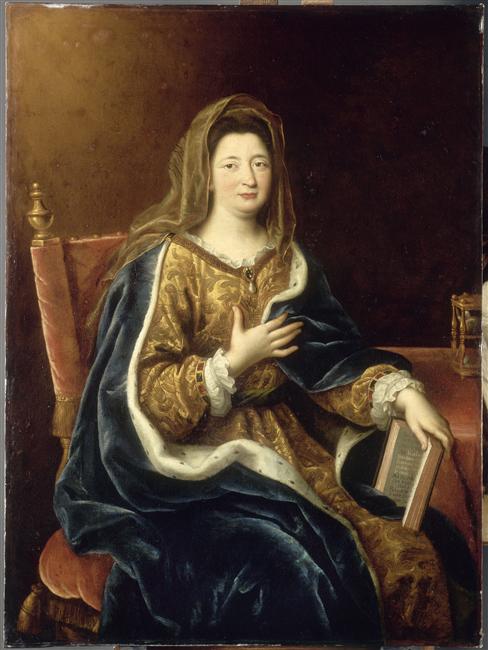
The probably greatest achievement of the Marquise, who was courtier in public and Queen in private, was the girls school at Saint-Cyr. The Maison Royale de Saint-Louis was a place where “the daughters of gentlemen who have been killed or exhausted their health or their fortune in the service of the State” could receive a worthy, or what the Marquise considered to be so, education. They entered the school between the ages of seven and twelve and were sorted in little groups, who were distinguished by their garments. The school uniforms were brown muslin robes, inspired by the gowns of the court, tied with ribbons whose colour indicated the wearer’s class. Red for those aged seven to ten, green for eleven to fourteen, yellow for fifteen and sixteen, and blue for those aged seventeen to twenty.
The King himself decided on who the school admitted, after consulting with experts on French genealogy who could guarantee that applicants possessed at least four generations of noble birth on their father’s side. Many of the Demoiselles de Saint-Cyr were daughters, nieces or orphans of soldiers. The students were housed at Saint-Cyr until they reached 20 and were not supposed to leave it until that age, unless in cases of dismissal, marriage or “exceptional family circumstances.” When they left the school at the end of their studies, they received a dowry of 3,000 livres either for a suitable marriage or to allow them to enter a convent.
The girls of Saint-Cyr were very dear to the Marquise and the King. In 1689 Racine’s Esther premiered in the school in presence of the King, who enjoyed it greatly and ordered it to be preformed again. Madame de Maintenon was not too pleased about it. She feared her students might become too proud, due to the praise they received, and might be prey for the handsome young men that came to watch the performance.
It was to Saint-Cyr that the Marquise retired after the death of her husband. There she continued a humble life until her death on April 15 in 1719 and was buried in the choir at Saint-Cyr. Her possessions went to her niece Françoise Charlotte d’Aubigné, which she held very dear, and had arranged for to marry the Duc de Noailles.

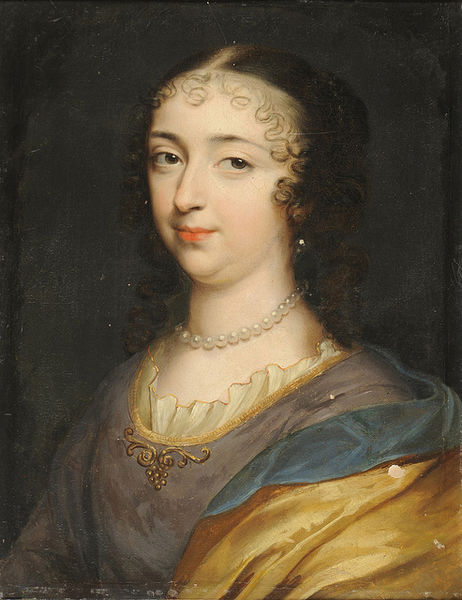

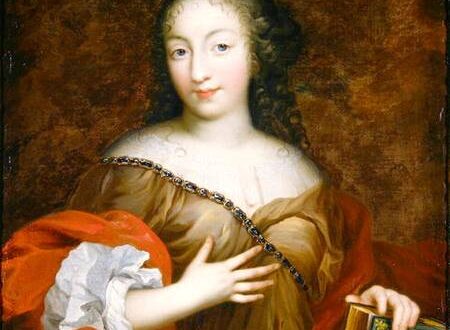
One Comment
audrey
waouw very interesting blog and esthetic presentation
congrats